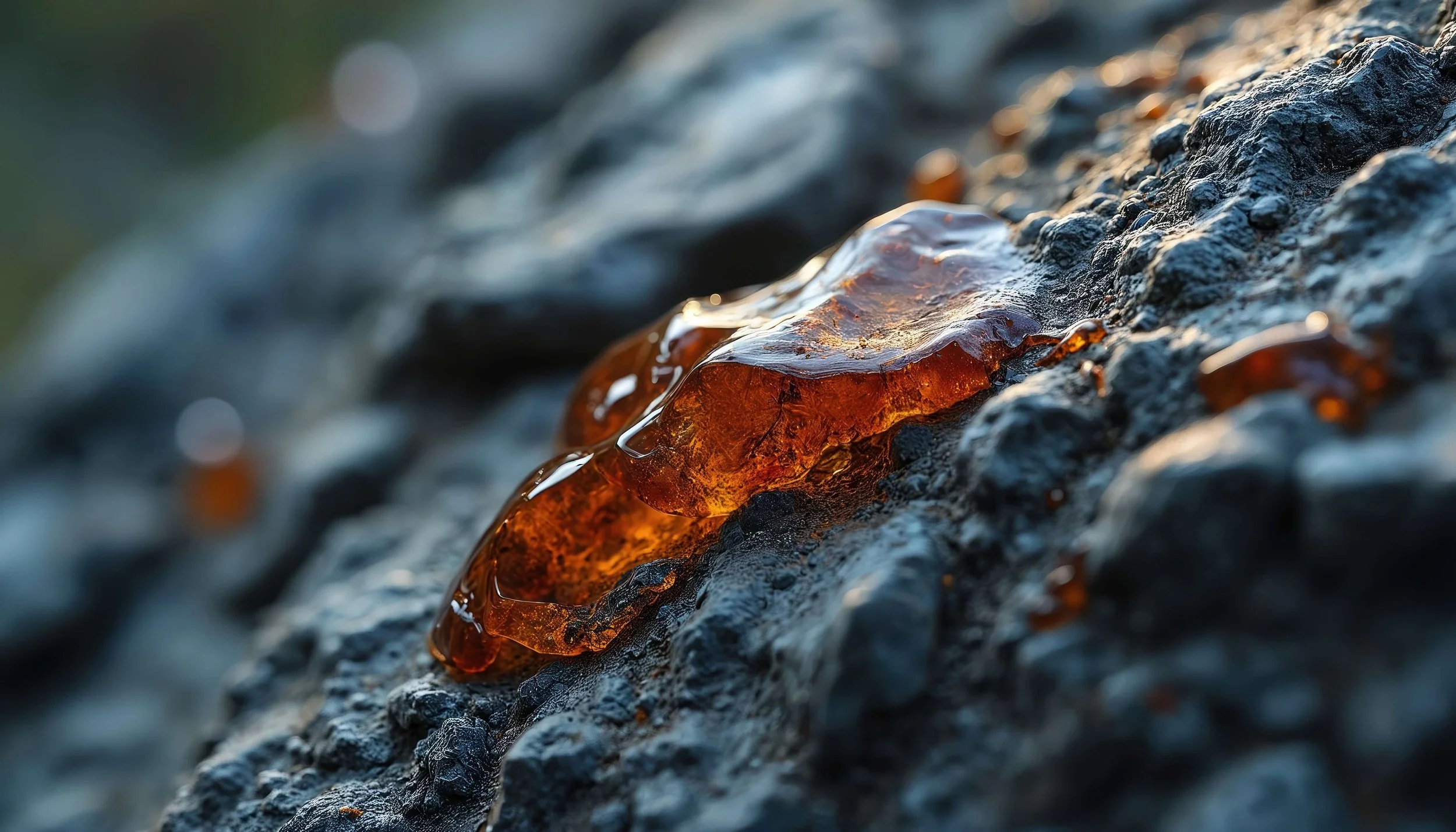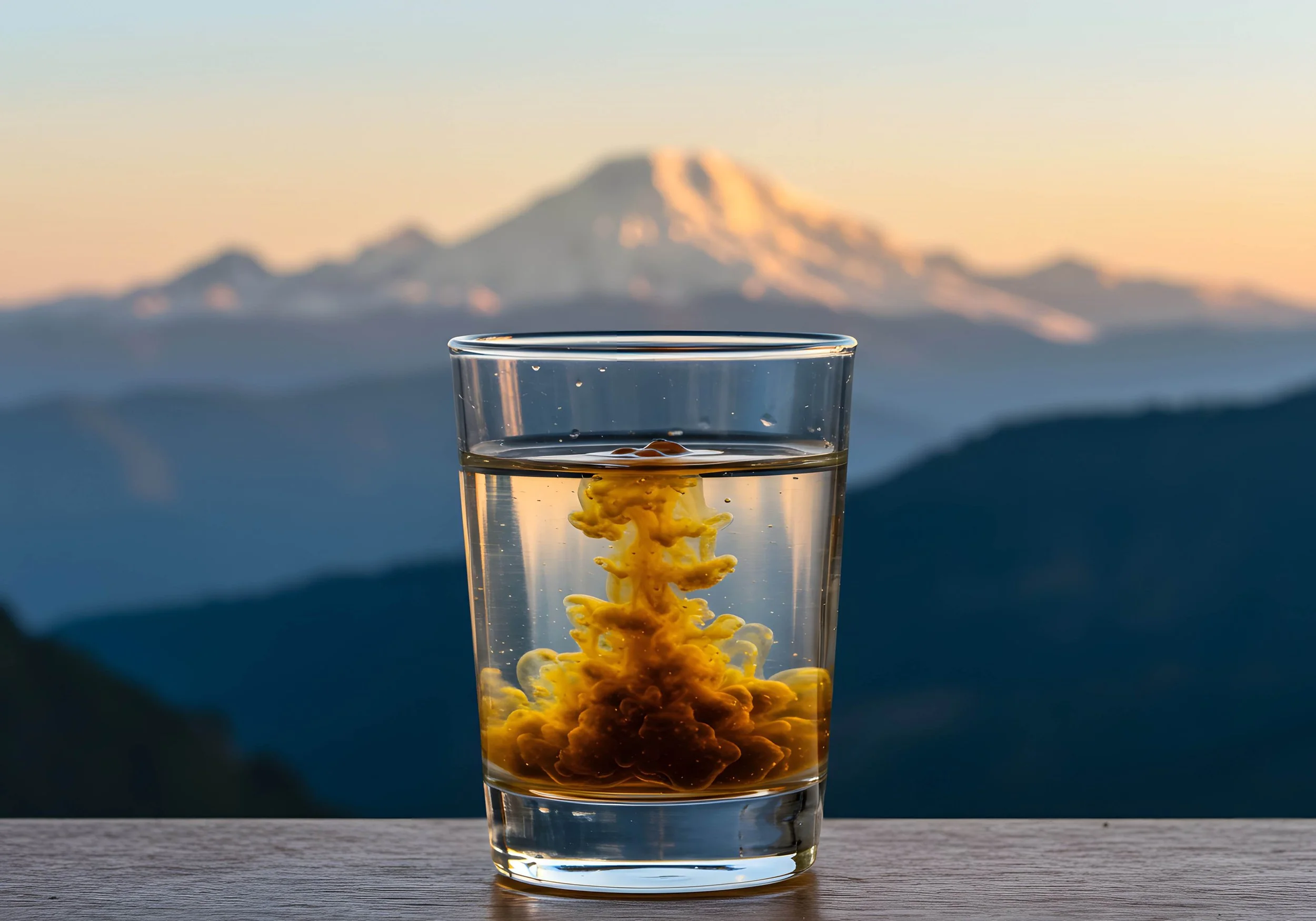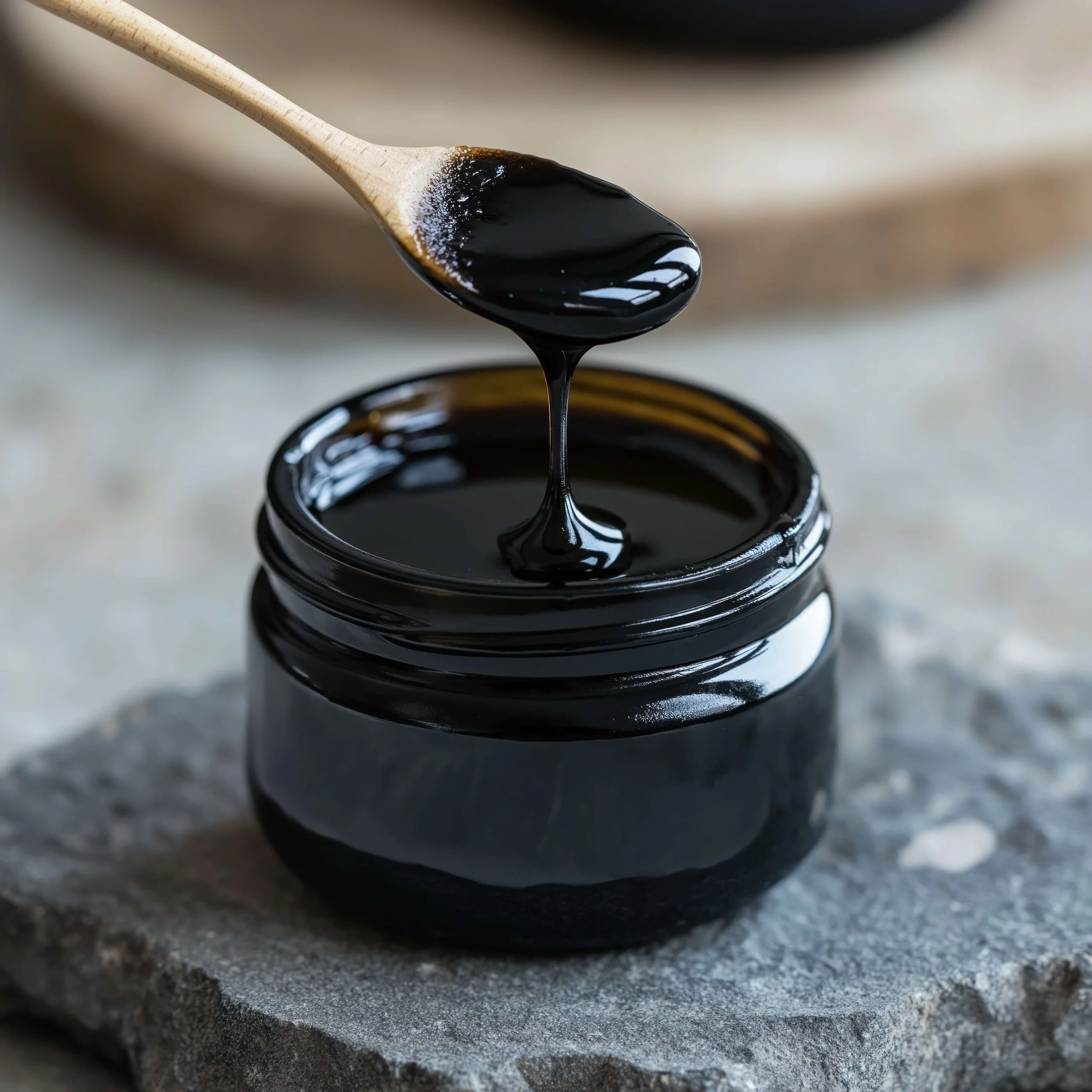Shilajit: Is This the Ultimate Ayurvedic Superfood?
For centuries, Ayurveda has provided us with potent remedies sourced from nature. Among these, Shilajit stands out as a remarkable substance revered for its rejuvenating and health-enhancing properties. As for me, I discovered Shilajit about 5 years ago when a friend enquired. When, I researched about it that time, it just blew my mind how amazing Shilajit is. But what exactly is Shilajit, and does it live up to the hype as the ultimate Ayurvedic superfood? Let's dive deep into the world of Shilajit and explore its benefits, uses, and significance in Ayurveda.
Sticky, tar-like Shilajit resin, an Ayurvedic remedy.
What is Shilajit? A Gift from the Mountains
Shilajit, a Sanskrit word meaning "conqueror of mountains" and "destroyer of weakness," is a sticky, tar-like substance that oozes from rocks in the Himalayas and other high-altitude mountain ranges during the summer months (Meena et al., 2010). Formed over centuries from the decomposition of plant and organic matter, Shilajit is a rich source of minerals, fulvic acid, humic acid, and other bioactive compounds.
In essence, Shilajit is a concentrated source of the earth's energy, harnessed by nature over millennia.
Shilajit in Ayurveda: The Elixir of Life
Shilajit holds a prominent place in Ayurvedic medicine, where it is considered a rasayana – a rejuvenating tonic that promotes physical and mental well-being. Ancient Ayurvedic texts, such as the Charaka Samhita and Sushruta Samhita, describe Shilajit as a powerful remedy for a wide range of ailments, from fatigue and weakness to diabetes and respiratory problems. For more than 3000 years, Shilajit has been used for prevention and treatment including fractures, osteoarthritis, spondylosis, chronic bronchitis, nervous disorders, epilepsy, anemia, angina, jaundice, menorrhagia and eczema. In Nepal, the Sherpa claim to have Shilajit as a part of their diet with very high level of healthy longevity (C. Aladi & R. Vikhe, 2022; Shankar Pandey, 2019; Wilson et al., 2011)
Ayurvedic practitioners recognize Shilajit's unique ability to balance all three doshas (Vata, Pitta, and Kapha), making it a versatile and valuable addition to any wellness regimen.
The Science Behind the Superfood: Exploring Shilajit's Benefits
Modern research has begun to validate many of the traditional uses of Shilajit, revealing its potential benefits for (Higuera, 2017; Meena et al., 2010; Bhavsar et al., 2016; Pandit et al., 2015; Usharani & Chandrasekhar, 2022; Carrasco-Gallardo et al., 2012; Gupta et al., 2021; Andrade et al., 2023):
Energy and Vitality: Shilajit is known to boost energy levels, reduce fatigue, and improve physical performance. The various mineral and compounds play a role in enhancing mitochondrial function, the process by which cells generate energy - powerhouse of a cell.
Cognitive Function: Shilajit may improve memory, focus, and cognitive function. It has been linked to positive effects in protecting brain cells from damage and enhance the activity of neurotransmitters involved in learning and memory. Studies are showing the fulvic acid, the primary component in Shilajit, blocks tau self-aggregation and may offer relevant path toward the study of Alzheimer's therapy.
Immune Support: Shilajit is a rich source of minerals such as iron, copper, zinc, magnesium and selenium. These are important for enzyme activation, to strengthen the immune system and protect against illness, and for bone health.
Anti-Aging: Shilajit's high concentration of antioxidants can help to combat free radical damage, a major contributor to aging and age-related diseases. The mineral copper and zinc in Shilajit help promote collagen synthesis and maintenance of connective tissue, which is essential for maintaining healthy skin, joints, and tissues.
Male Reproductive Health: Shilajit has traditionally been used as an aphrodisiac and to improve male reproducitve health function. Studies have shown that it can increase testosterone levels, sperm count, and sperm motility.
High-Altitude Problems: Research suggests that Shilajit can help the body adapt to high-altitude stress, improving oxygen utilization and reducing symptoms of altitude sickness.
Osteoarthritis (OA): OA pain is linked to oxidative stress and inflammation. Some studies indicate that Shilajit, either alone or in combination with other substances, may reduce arthritic pain through antioxidative and anti-inflammatory processes. Shilajit’s benefits—such as immune support, bone healing, increased muscle mass, enhanced endurance, and antiaging effects—may also contribute to this improvement.
Shilajit nature’s gift.
Conquer and improve your weakness.
How to Use Shilajit: A Practical Guide
Shilajit is available in various forms, including powder, resin, and capsules.
Powder: Mix Shilajit powder with warm milk, water, herbal tea or as directed on the product label.
Resin: Dissolve a grain of rice or pea-sized amount of Shilajit resin in warm water or milk.
Capsules: Take Shilajit capsules with water as directed on the product label.
It's important to purchase Shilajit from a reputable source to ensure its purity and quality. Look for products that have been tested for heavy metals and other contaminants.
Important Considerations: Safety and Side Effects
While Shilajit is generally considered safe, it's important to be aware of potential side effects and precautions (Higuera, 2017; Shilajit: Health Benefits, Uses & Side Effects | Tata AIG Blog, 2024) :
Heavy Metals: Some Shilajit products may contain heavy metals. Choose products that have been tested for purity.
Fungal Contamination: Raw and unprocessed Shilajit may be contaminated with fungi. Purchase Shilajit from a reputable source that processes it properly.
Uric Acid: Shilajit may increase uric acid levels. People with gout should use it with caution.
Pregnancy and Breastfeeding: There is limited research on the safety of Shilajit during pregnancy and breastfeeding. Consult with a healthcare professional before use.
Interactions: Shilajit may interact with certain medications. Talk to your doctor before using Shilajit if you are taking any medications.
Blood conditions: Must avoid Shilajit if you have Sickle Cell Anaemia, Hemochromatosis, or Thalassemia.
Is Shilajit the Ultimate Ayurvedic Superfood?
Shilajit is undoubtedly a remarkable substance with a rich history of use in Ayurveda and a growing body of scientific evidence to support its health benefits. While it may not be a "magic bullet," Shilajit offers a potent and natural way to enhance energy, immunity, cognitive function, and overall well-being.
However, it's important to remember that Ayurveda is a holistic system, and Shilajit is most effective when combined with a balanced diet, healthy lifestyle, and personalized guidance from a qualified practitioner.
Ayurvedic herbs and Shilajit for holistic health.
Ready to experience it?
Is Shilajit right for you? Contact REVIVE Ayurveda today to schedule a consultation and learn if Shilajit or any other remedy is appropriate for you and/or can be integrated into your personalized wellness plan!
Written by Ann Pallis, Ayurvedic Practitioner in Ashburton, Melbourne.
Disclaimer: This blog post is for Ayurveda informational purposes only and does not constitute medical advice. This information is not intended for use in the diagnosis, treatment, cure or prevention of any disease. Please consult with a qualified healthcare professional before using Shilajit or any other herbal remedy.
REFERENCES
Higuera, V. (2017, June 2). 9 Benefits of Shilajit. Healthline; Healthline Media. https://www.healthline.com/health/Shilajit#alzheimers
Wilson, E., Rajamanickam, G. V., Dubey, G. P., Klose, P., Musial, F., Saha, F. J., Rampp, T., Michalsen, A., & Dobos, G. J. (2011). Review on Shilajit used in traditional Indian medicine. Journal of Ethnopharmacology, 136(1), 1–9. https://doi.org/10.1016/j.jep.2011.04.033
C. Aladi, P., & R. Vikhe, S. (2022). SHILAJIT: A WONDER DRUG OF AYURVEDA [Review of SHILAJIT: A WONDER DRUG OF AYURVEDA]. WORLD JOURNAL of PHARMACEUTICAL and MEDICAL RESEARCH, 8(4), 125–127. http://www.wjpmr.com
Shankar Pandey, P. (2019). Shilajit - A Wonder Drug of Ayurveda: An Overview [Review of Shilajit - A Wonder Drug of Ayurveda: An Overview]. Int. J. Pharm. Sci. Rev. Res., 59(1), 140–143. ISSN 0976 – 044X International. www.globalresearchonline.net
Meena, H., Pandey, H., Arya, M., & Ahmed, Z. (2010). Shilajit: A panacea for high-altitude problems. International Journal of Ayurveda Research, 1(1), 37. https://doi.org/10.4103/0974-7788.59942
Shilajit: Health Benefits, Uses & Side Effects | Tata AIG Blog. (2024). www.tataaig.com. https://www.tataaig.com/knowledge-center/health-insurance/health-benefits-of-Shilajit
Bhavsar, S. K., Thaker, A. M., & Malik, J. K. (2016, January 1). Chapter 51 - Shilajit (R. C. Gupta, Ed.). ScienceDirect; Academic Press. https://www.sciencedirect.com/science/article/abs/pii/B9780128021477000516
Pandit, S., Biswas, S., Jana, U., De, R. K., Mukhopadhyay, S. C., & Biswas, T. K. (2015). Clinical evaluation of purified Shilajit on testosterone levels in healthy volunteers. Andrologia, 48(5), 570–575. https://doi.org/10.1111/and.12482
Usharani, P., & Chandrasekhar, N. (2022). Shilajit extract reduces oxidative stress, inflammation, and bone loss to dose-dependently preserve bone mineral density in postmenopausal women with osteopenia: A randomized, double-blind, placebo-controlled trial. Phytomedicine, 154334. https://doi.org/10.1016/j.phymed.2022.154334
Carrasco-Gallardo, C., Guzmán, L., & Maccioni, R. B. (2012). Shilajit: A Natural Phytocomplex with Potential Procognitive Activity. International Journal of Alzheimer's Disease, 2012, 1–4. https://doi.org/10.1155/2012/674142
Gupta, R. C., Kalidindi, S. R., Doss, R. B., Lall, R., Srivastava, A., & Sinha, A. (2021). Nutraceuticals in arthritis. Elsevier EBooks, 193–214. https://doi.org/10.1016/b978-0-12-821038-3.00014-8
Shilajeet - an overview | ScienceDirect Topics. (2016). www.sciencedirect.com. https://www.sciencedirect.com/topics/pharmacology-toxicology-and-pharmaceutical-science/shilajeet
Andrade, V., Wong-Guerra, M., Cortés, N., Pastor, G., González, A., Calfío, C., Guzmán-Martínez, L., Navarrete, L. P., Ramos-Escobar, N., Morales, I., Santander, R., Andrades-Lagos, J., Bacho, M., Rojo, L. E., & Maccioni, R. B. (2023). Scaling the Andean Shilajit: A Novel Neuroprotective Agent for Alzheimer’s Disease. Pharmaceuticals, 16(7), 960. https://doi.org/10.3390/ph16070960



